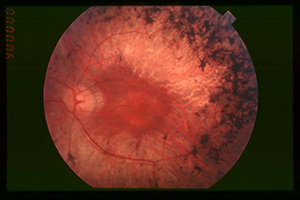 |
|
Weighing only 10-15 pounds and about 4 feet in length from snout to tail tip, pint-sized Eodromaeus may be the oldest ancestor to date of all meat-eating dinosaurs, including T. rex. Illustration by Todd Marshall. |
What may be the earliest known relative of T. rex and all meat-eating dinosaurs has been discovered. The dog-sized mini-predator would’ve made its future relatives proud as it fed on small dinosaurs and the young of other reptiles, and is now shaking up what scientists had previously learned about the evolution of those extinct giants.
The small, lanky, two-legged carnivore named Eodromaeus murphi—Eodromaeus being Greek for “dawn runner,” murphi in honor of field volunteer Jim Murphy—weighed only 10 to 15 lbs (4.5 to 6.8 kg) and measured about 4 ft (1.2 m) in length from snout to tail. The skeletons of two specimens were discovered side-by-side in 230-million-year-old iron-rich stone in the “Valley of the Moon” at the foothills of the Andes in northeastern Argentina, which was once the southwest corner of the supercontinent Pangaea.
“With a hike across the valley, you literally walk over the graveyard of the earliest dinosaurs to a time when they ultimately dominate,” said researcher Ricardo Martinez, a paleontologist at the National University of San Juan in Argentina.
Dino graveyard
The predator came from the dawn of the age of dinosaurs, a time we know relatively little about. The long-necked, long-tailed predator was armed with saber-shaped upper cheek teeth and sharp-clawed five-fingered hands.
“Seeing what a modest beginning this lineage had, no one would have ever thought it would evolve to giant predators like T. rex,” researcher Paul Sereno, a paleontologist at the University of Chicago, told LiveScience.
Sereno, Martinez and their colleagues concluded Eodromaeus was likely a very close relative of the ancestor of the theropod lineage, which includes all predatory dinosaurs. Key features it had in common with theropods include long finger bones tipped with claws that enhance grasping, and pockets in the sides of the neck vertebrae for air sacs from the lungs.
“It really is the earliest look we have at the long line of meat eaters that would ultimately culminate in Tyrannosaurus rex near the end of the dinosaur era,” Sereno said. “Who could foretell what evolution had in store for the descendants of this pint-sized, fleet-footed predator?”
Eodromaeus’ plant-eating twin
The area was once a verdant valley, judging by all the petrified wood found there. Sediments covered the skeletons over a period of 5 million years, eventually building up in thickness to more than 2,000 feet (700 meters). Volcanoes associated with the nascent Andes Mountains occasionally spewed volcanic ash into the valley, allowing the researchers to use radioactive elements in the ash layers to help determine the age of the sediments.
The rocks in which these fossils were found have proven a treasure trove of discoveries from the earliest days of dinosaur evolution, including Eoraptor, or “dawn thief,” another creature from very close to the root of the dinosaur family tree. This reptile, which Sereno and his colleagues discovered in 1991, also ran on two legs and was similar in size, and until recently, they believed Eoraptor was a very primitive theropod as well.
However, with these new fossils for comparison, the researchers see the plant-eating Eoraptor was actually an early ancestor of the sauropod lineage, which includes the giant, long-necked herbivores that were the largest animals to ever walk the Earth. Eoraptor lacked theropod-like features seen in Eodromaeus, such as an opening near the end of the snout, and had more sauropod-like features, such as enlarged nostrils and an inset first lower tooth.
“That will be a surprise for a lot of people,” Sereno said.
Evolutionary experimentation
When it came to mistakenly classifying Eoraptor as more like a theropod than a sauropod, Sereno apologetically said, “What can I say, I was young.” He did note, however, “that if you were transported back 230 million years, and you turned your head as they ran by, you would be really hard-pressed to tell them apart. The differences at the root of the dinosaur family tree are really subtle. And no one else saw it, either.”
The general similarities between the two dinosaurs suggest that the three main groups of dinosaurs—sauropods, theropods and “bird-hipped” ornithischians such as stegosaurs, ankylosaurs and Triceratops—did share an overall body plan.
“We’re looking at a snapshot of early dinosaur life,” Sereno said. “Their storied evolutionary careers are just unfolding, but at this point they’re actually quite similar.”
“The dawn of the age of dinosaurs is coming into focus,” Martinez said.
In the red cliffs on the far side of the Valley of the Moon, larger plant- and meat-eating dinosaurs from further back in time had evolved to be many times the size of Eoraptor and Eodromaeus, but it would be even later when dinosaurs overcame their rivals to dominate all land habitats in the succeeding Jurassic and Cretaceous periods, beginning some 200 million years ago.
“The story from this valley suggests there was no single advantage or lucky break for dinosaurs, but rather a long period of evolutionary experimentation in the shadow of other groups,” Sereno said. “We now hope to find things that predate the first dinosaurs—that is where the gap is now.”
The scientists detailed their findings in the Jan. 14 issue of the journal Science.

|











